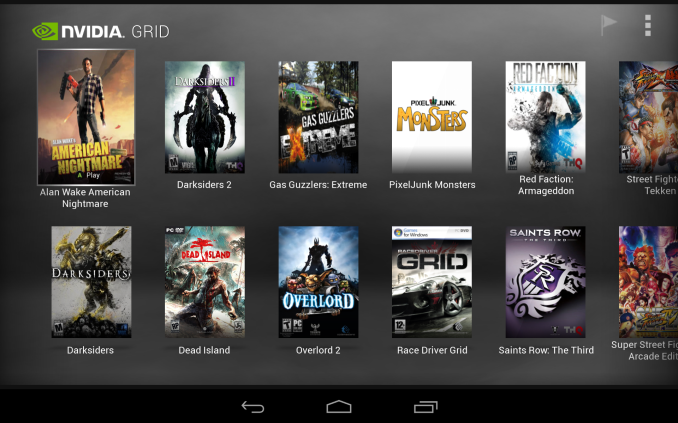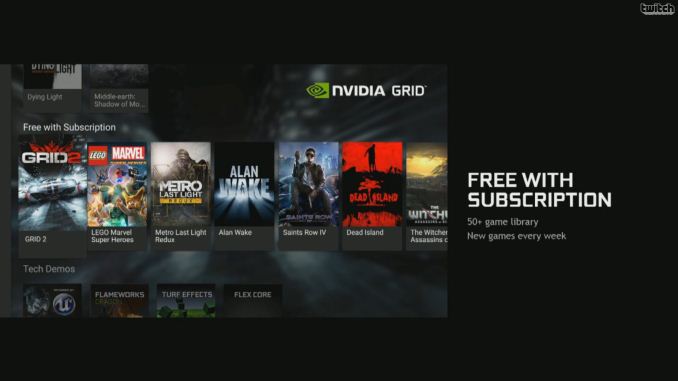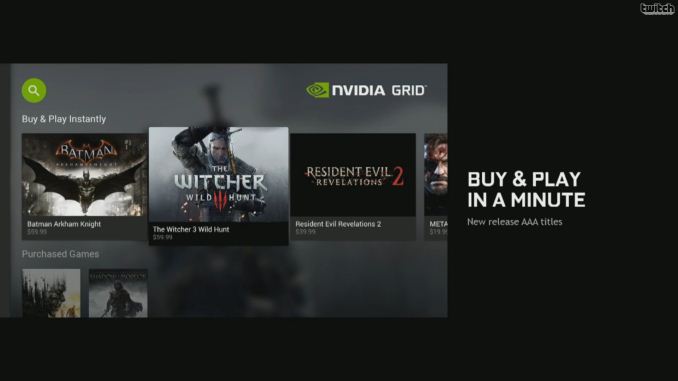NVIDIA GRID Game Streaming Service To Become Commercial Service
by Ryan Smith on March 4, 2015 3:15 AM EST- Posted in
- Software
- Cloud Computing
- Shield
- NVIDIA
- GRID

As part of NVIDIA’s suite of GDC 2015 announcements, the company has announced that their GRID game streaming service is getting a promotion from beta to a commercial service.
First introduced back in 2013 as a beta project for NVIDIA’s SHIELD Portable to demonstrate the streaming capabilities of the combined Kepler + Tegra ecosystem, the GRID gaming service has been slowly built up over the years. Later in 2013 NVIDIA added console mode, extended the service to the SHIELD Tablet, and most recently the company has greatly expanded the number of games and server locations the still-in-beta service offered. All signs as of late have pointed to NVIDIA seeking to bring the service out of beta – particularly the June 30th expiration date – and tonight’s announcement reflects exactly that.
The commercial version of the service will launch in May alongside the SHIELD Console, and while maintaining the overall design and feel of the current beta service, NVIDIA will be making changes to accommodate its switch from a purely free service. First and foremost the service will see 2 tiers introduced: basic and premium. Both tiers come with free games, similar to the current GRID beta, with the premium tier getting additional (and likely more recent) games. NVIDIA has not yet announced a price for either tier, however NVIDIA has been careful to call both tiers “subscription” tiers, and with subscription running orthogonal to free, there’s reason to believe that both will be paid services.
As for the newest and greatest games (that NVIDIA presumably can’t get service-wide licenses to), NVIDIA will also offer a game purchasing service to allow users to buy individual games. This functionality does not exist in the current GRID beta, but of the few preview screens we’ve seen it looks like pricing will be in-line with retail PC game purchases.
Meanwhile for non-SHIELD owners hoping to take advantage of GRID, it’s looking like you will be out of luck. NVIDIA is currently only talking about GRID for SHIELD device owners, which is consistent with their use over the last few years of value add features to drive hardware sales. GRID exists to sell SHIELD consoles, not for NVIDIA to get into the business of running a game streaming service.
In fact the launch of a commercial version of the GRID service is something of a change in direction for the company. NVIDIA’s original plans for GRID involved partnering with game streaming start-up Gaikai, a plan that came to a halt when Sony bought Gaikai and used them to build Playstation Now. Since then we haven’t seen any other serious contenders in the PC game streaming space, and NVIDIA for their part has opted to go it alone.
Meanwhile from a technical perspective, the GRID service has not substantially changed since beta. Now that NVIDIA has expanded beyond San Jose, the actual server locations are being backed via Amazon’s AWS, which is already a large customer of NVIDIA GPUs. NVIDIA’s target to beat on lag is 150ms, a number the company believes is fast enough to be reasonably playable, but also because that’s the number the company has previously stated they believe they need to be at to be competitive with consoles – especially games that only update at 30Hz.

NVIDIA On GRID Latency in 2012
Wrapping things up, NVIIDA tells us that when the commercial service launches in May, the company will offer 50+ games, with that expanding to 100 by the end of the year. In the meantime we will be keeping our eyes peeled to see what the subscription price of the service will be and how many server sites will part of the commercial launch.













17 Comments
View All Comments
Tigran - Wednesday, March 4, 2015 - link
In last year's Shield Tablet review AnandTech mentioned "10 Mbps connection and around 10ms latency to the server". 150ms sounds not too good.Ryan Smith - Wednesday, March 4, 2015 - link
150ms is the total value (network + encode + display + etc)Tigran - Wednesday, March 4, 2015 - link
So it was also about 150ms total value in last year's review?WagonWheelsRX8 - Wednesday, March 4, 2015 - link
I just want to know where they are getting the 100 ms 'game pipeline' figure from. That sounds atrociously high. I'd gather in a well coded game it wouldn't be more than 1 frame which would be ~33ms for a game running at 30fps. Half that time for 60fps. Can anyone elaborate?jjj - Wednesday, March 4, 2015 - link
You are wrong about he tiers.The basic one is 720p 30 FPS and the premium one (called GRID Plus) is 1080p 60FPS.
As for additional games for GRID Plus, i really don't remember any mention of that in the event or press release so maybe check that too. They state that they have 50 games now and they keep adding more but that's about it.
Yojimbo - Wednesday, March 4, 2015 - link
The premium games are 1080p 60FPS, you are right, but they are also a potentially different set of games you must buy on top of the subscription. He did mention that in the event. I think the idea is the latest releases will be sold on premium and then at some point they will migrate down.Guspaz - Wednesday, March 4, 2015 - link
The choice of 30FPS for the basic tier is odd; 30FPS would significantly increase latency, and make people who try it out more likely to say "This is too laggy, it's garbage" and then never subscribe to the premium service.On the other hand, if the basic tier was 720p60, they'd be more likely to say "Hey, this works really well, I want to subscribe to get higher resolution and more games".
Murloc - Wednesday, March 4, 2015 - link
the basic tier isn't free either, and they're probably going to offer some way to try out the premium service if you already have basic to see the difference.I don't see how 30 fps would significantly increase latency anyway. Considering the latency that there is because of the streaming stuff, a 16 ms worst-case difference isn't that significant.
jjj - Wednesday, March 4, 2015 - link
It's a matter of cost and the quality ofthe internet connections people have. Less might be better for a lot of people that have poor connections . 60FPS would double the bandwidth and plenty US users don't have the connection needed for even 720p at 30FPS.The device is unlikely to sell much anyway at 199$ and it will be mostly in the US. In EU, Nvidia jacks up prices anyway and that's before adding 19 to 25% VAT so EU pricing will be quite a bit higher for a device that already is twice the established price for Android TV boxes.
So it's still more of a testing phase for now , Nvidia doesn't seem interested in actually having customers and they are just trying to figure out costs and what kind of pricing is achievable.
Right now anyone that buys this does so because they really want GRID, otherwise they can just pay half the price for the Amazon box ( or Razer Forge TV or w/e else that is sufficient for Android games) and if you don't need gaming, Chromecast.is 6-8 times cheaper.
SpartyOn - Wednesday, March 4, 2015 - link
I own an original Shield Portable and love it. Even if it didn't come with all the other features that are included, it's the by far the best handheld emulator device on the market. I spend more time playing my old PS1, Genesis, and SNES games than anything else. Having a built-in controller device while sitting back on a lounger in the pool doing some retro gaming is boss.I have streamed games via the GRID service over wireless and I did not notice any discernible impact on my gameplay other than in twitchy racing games (45MB down/5MB up connection). For me, it simply worked great, and that was even on shitty single band wireless-N (I've since upgraded to dual AC). Having the console plugged into Ethernet should improve on that experience in terms of lag.
Local GameStream from the PC has had its ups and downs. It worked great for a long time and I used it to stream games like Deus Ex: HR, Skyrim, Kingdoms of Amalur, a few LEGO games, and The Witcher 2 without any issues from soon after it's launch to about October 2014. Some of the recent Geforce Experience PC updates (Nov. 2014-early Feb. 2015) broke a lot of functionality for me though and I was having connection issues, dropped signals, jerky streams, and just overall less performance. However, they seem to be working out the bugs that were introduced with subsequent releases and I have seen my performance improve to I think about where it was since the last release.
What disappoints me about this console is that, for the most part, my Shield Portable does all of these things already. If I want to stream GRID games or PC games via GameStream to my TV, I can hook it up via HDMI and use an XBOX wireless controller. Want to play Android games on the TV? Same thing. Bluetooth voice control accessories? Check. This new console just has more performance, which is to be expected for a larger and newly released device.
I was really hoping they were going to release an update to the handheld with the X1 and market it as a portable home console. Increase the screen size to at least 6" from the current 5", slap a high resolution screen in it, throw in the X1 with active cooling just like the original shield, put 3-4GB of RAM in and call it a day. All you would need to do to get all of the functionality of a home console would be to plug it in via HDMI if you just wanted to leave it on the shelf, but the portability factor would be there if you wanted it. The Shield Portable and Tablet were already niche products for a niche audience and instead of perfecting them, they've released this device that honestly, I don't know who it's for.
I mean, the X1 can probably handle PS2 games now as soon as someone releases a Android emulator. Wouldn't that be sweet to have in a handheld, plus all the benefits they are touting with the X1?